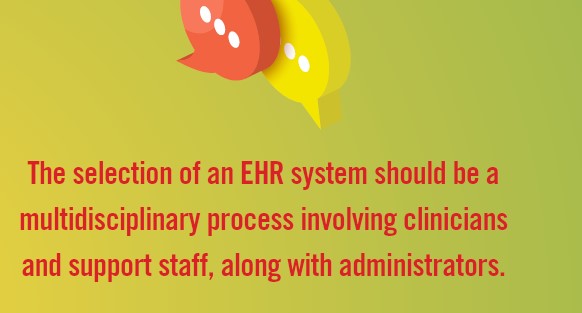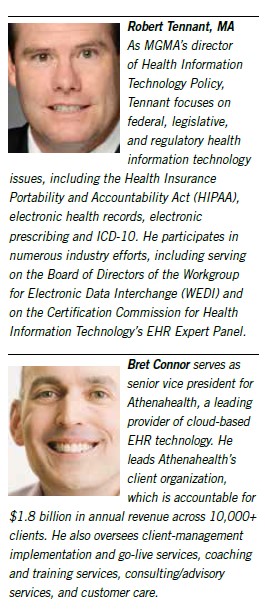When correctly implemented, electronic health record (EHR) systems can help physicians deliver safe, quality care. In a national survey of physicians conducted by the U.S. Department of Health and Human Services, 75% reported that their EHRs improved patient care, and 88% found that their system generated clinical benefits for the practice.
Research that shows the right EHR system can reduce risk and save money for healthcare organizations. A study published in
Healthcare Financial Management reported that a community hospital saw a 60% decrease in near-miss medication events after implementing an EHR system. Another study published in the Southern Medical Journal found that using an EHR facilitated improvements to documentation and coding that yielded a cost savings of more than $100,000. In a seven-year study of Pennsylvania hospitals published in the American Economic Journal, EHR system adoption resulted in “a 27% reduction in aggregated patient safety events, a 30% decline in negative medication events, and a 25% decrease in complications regarding tests, treatments, or procedures.”
But EHR systems are most effective at reducing errors and improving safety when they fit seamlessly into an organization's goals, culture, and clinical practices. When they don't, substantial risk-management and reimbursement challenges can arise, according to Bret Connor, senior vice president and chief customer officer with Athenahealth, a provider of cloud-based EHR technology. “The closure of key care gaps has become much more complex than in the past,so it’s critical that the EHR tool can keep up,” he says.
The following considerations will help organizations select, integrate, and employ an EHR system that delivers multifaceted value, both as an enhancement to clinical practice and as a valuable error-prevention tool.

CONSIDERATION 1: STAKEHOLDER SUPPORT
The first challenge for practices is determining which EHR system to select, says Robert Tennant, director of health information technology policy for the national Medical Group Management Association (MGMA). “We’re talking about an enormous change to both the administrative and clinical sides of the organization, and a significant investment for the practice in terms of staff time and financial resources,” he says. “With this in mind, it is critical to make the right software choice.”
The selection of an EHR system should be a multidisciplinary process involving clinicians and support staff, along with administrators. Allowing the end users of an EHR system to provide input in the selection process helps eliminate unwanted surprises down the road, notes Tennant. He also recommends speaking with colleagues in other organizations who have successfully selected and implemented an EHR system, particularly those with firsthand experience related to systems you’re considering.
“In addition to discussing the products with the vendors and viewing demos, we recommend reaching out to colleagues in similar-sized practices and in the same specialty who have implemented an EHR,” says Tennant. “Talking directly to end users, not just to sales representatives, will give you more unbiased perspectives on the performance of the software in real-world applications, and a better insight
into the vendor-contracting process.”
CONSIDERATION 2: SUSTAINABILITY
A sustainable, safety-enhancing EHR system must fit comfortably within an organization’s budget, both now and for years to come. Costs for EHR implementation and maintenance vary widely, depending on the needs of each healthcare organization. According to research and consulting firm EHR in Practice, a typical EHR implementation costs $162,000 for a small physician group and $5–20 million for a hospital. But implementation costs are only one part of the system’s long-term costs. To accurately compare pricing between prospective EHR systems, organizations must consider maintenance and other fees associated with the system’s total cost of ownership.
“Critical for the practice, as you develop your project budget, is clearly understanding your financial commitment in terms of both the up-front price of the software and the ongoing maintenance fees,” says Tennant. “Also, inquire about any potential add-on expenses, such as the cost for additional training or fees for modifying clinical templates.”
An EHR’s hidden costs are any expenditures not included in its up-front pricing, from licensing and maintenance to consulting and labor.
Even less obvious are the costs like decreased revenue or reduced patient volumes during EHR implementation or transition. “Inevitably, however much you expected to pay, you always end up spending more,” says Tennant.
CONSIDERATION 3: SCALABILITY
The ideal EHR system is both reliable and responsive, serving an organization’s current needs with the ability to adapt rapidly to growth,
regulatory changes, and emergency scenarios. “When a medical practice is making technology decisions, I suggest they choose a platform that is modern, scalable, and easy to use for both providers and staff, and that will deliver great outcomes,” says Connor.
Modern cloud-based EHR systems offer maximum flexibility for growth and organizational change, notes Connor, because adjustments and updates to the organization’s system can be rolled out across an entire health system almost immediately. This allows multihospital systems to operate seamlessly and continuously as updates take place.But most healthcare systems still use on-site hosted EHR systems that differ from clinic to clinic or hospital to hospital, making them more difficult to scale, adjust, and maintain.
“Healthcare lags behind other industries in the adoption of modern technology solutions,” Connor notes. “As far as EHR, practice-management, and revenue-cycle solutions go, most healthcare providers are still using on premise technology or hosted versions of on-premise software. I would estimate that 90% of the industry is still utilizing these legacy models.” When evaluating prospective EHR vendors, inquire about how the system is updated, scaled, and modified. Do system updates or additions take place on-site, or in the cloud? Additionally, inquire about how data from another practice or organization might be integrated into the system in the event or a merger,
acquisition, or consolidation.
CONSIDERATION 4: REVENUE MANAGEMENT
Securing medical records for billing and Medicare reimbursement are critical for healthcare organizations, notes Tennant. “Patient medical and billing records are the lifeblood of the practice and must be protected,” he says. “If you’re moving to an EHR, you need to work with your vendor to determine the most appropriate approach to backing up these data. With the two most important words in practice management
being ‘what if,’ the practice must establish protection and contingency protocols in the event of the data being compromised due to cyberattack, theft, and natural disasters such as fires or floods. Preferably, your data should be backed up in the cloud and immediately
accessible, should it be needed.”
“An EHR solution needs to integrate with an organization’s practice management system and its revenue cycle process,” agrees Connor. “It needs to be able to share clinical data with other systems. This connectivity is critical to success, providing a more holistic view of medical-practice performance and contributing to the delivery of high-quality care to patients.” Incorporating staff or administrators from an organization’s billing department into the selection and implementation process can help ensure that a new EHR system fits an organization's business practices as well as its clinical needs.
CONSIDERATION 5: CLINICAL INTERFACE
The most technologically advanced EHR won’t help reduce medical errors if it interrupts a physician’s preferred workflow or contributes to fatigue.By adding to a physician’s burgeoning workload, EHR systems can escalate physician burnout, according to research published in the Annals of Internal Medicine. “We know that EHR fatigue is contributing to burnout, so we’re thoughtful in the way we’ve designed our EHR platform,” says Connor. “We want to minimize the amount of attention people need to provide to their EHR, so we can free them up to provide care for patients.”
That means that selecting the right hardware—including workstations, tablets, laptops, or other devices—is every bit as important as choosing
the right software. “Selecting the appropriate clinical interface is often a critical factor in the overall success of the installation,” says Tennant. “Having a computer terminal with a screen that forces the physician to turn their back on the patient can be disruptive to the encounter, and off-putting to the patient and clinician alike. Practices should explore other options—could they use a tablet or a standing workstation? The hardware side of this is just as important as the software because the physicians and other staff need to be comfortable using the system.”
To avoid burdening providers and staff with cumbersome data-entry duties, prioritize efficiency and brevity for clinical hardware interfaces. In 2020,the American Medical Association reported that 80% of physicians experience fatigue in 22 minutes spent working with EHRs. Incorporating clinicians and staff members into an EHR selection and implementation process helps ensure that the system’s hardware will enhance rather than detract from patient-provider communication.
CONSIDERATION 6: INTEROPERABILITY
Modern EHR systems are increasingly connected and interoperable, facilitating quick, safe exchanges of real-time patient information. This is
transforming real-time point-of-care transactions, notes Tennant. “For a doctor to have the ability to use an EHR to access insurance authorizations,potential medication interactions,and other medical information during a patient visit, in real time, means that physicians can offer better, safer guidance to the patient,” he says.
“There is a new approach emerging: leveraging EHRs for real-time point-of-care transactions,” he adds. “This ability to exchange data using EHRs during the patient encounter using Fast Healthcare Interoperability Resources[FHIR] standards is the next big thing for practices. Remember to ask potential vendors during the vetting process: ‘What point-of-care services and FHIR standards does your product support?’ Interoperability has the potential to help physicians deliver safer care while addressing significant pain points facing physicians and
organizations today.”
